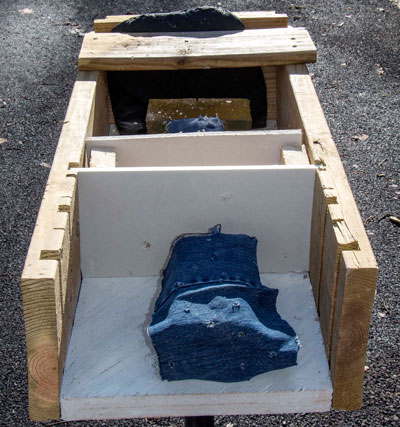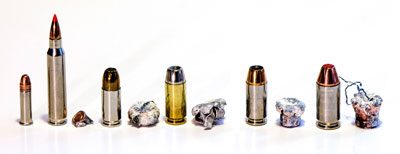
A bullet passing through a threat and continuing with the potential to cause unintentional damage to a bystander or object is a situation commonly described as over-penetration. The occurrence could be a bad thing if you shoot someone who is attacking you while your wife is standing behind the attacker. On the other hand, a bullet that passes through one bad guy and strikes another could be a good thing if the two are lined up to beat you with a claw hammer. Statistically speaking, neither incident is likely to occur.

But let's imagine a crazed murderer breaks into your home, and you shoot through him. Could that bullet continue through a wall and hit a family member or neighbor? Sure. I investigated a shooting where a 9 mm full-metal-jacket bullet passed through a car's windshield, head rest, back glass and the exterior wall of a nightclub. Over-penetration has the potential to be a problem, but its relevance is a point of contention—even among writers who regularly appear in this magazine.
Fellow gun scribe Bryce Towsley believes, "Over-penetration is every ambulance-chasing lawyer's best friend. In a fight you own every bullet you fire, and if one goes through the target and hits an innocent behind, it's your responsibility. You will have enough to think about during a fight for your life; keep the bullets in the bad guy."
Gunsite instructor and former Border Patrolman Ed Head has a different opinion. "I like to say over-penetration is overrated. Especially in a police context, worrying about whether a bullet will over-penetrate—when many of the rounds police fire miss the bad guy and endanger everyone in the neighborhood—doesn't make much sense. In my experience, lack of penetration and incapacitation are the real issues."
Statistics related to shootings seem to back Head's take on the matter. Missing happens much more often than wounds from over-penetration. Nationally, cops miss the bad guy about 75 percent of the time on average. It's reasonable to assume you may not shoot any better in a high-stress situation. When you miss, a bullet's ability to over-penetrate is of minimal concern; it will hit whatever it hits at full force.
While a bullet's ability to penetrate is certainly related to its ability to over-penetrate, it's also related, in part, to what makes it effective against a threat in the first place. Echoing the words of one of the greatest handgunners, Sheriff Jim Wilson sums up the need for adequate penetration by recalling, "Elmer Keith had it right; an exit wound lets more blood out and more air in." After all, our goal when we shoot an attacker is to stop the attack. We increase our odds by using ammunition that has the best chance of bringing about that stop.
To the Test
All these experienced shooters are worth listening to, but I trust evidence more than advice. I conducted a series of tests in order to see firsthand what, if any, real concerns over-penetration might present. The results, though not definitive by any means, do give a glimpse into the over-penetration potential that exists with defensive-handgun ammunition.
I performed four tests with four defensive-handgun loads representing 9 mm, .40 S&W and .45 ACP. The first test verified previously established expansion and penetration in 10-percent ordnance gelatin. The second determined the bullet's velocity after passing through 8 inches of gelatin. The third involved shooting through an 8-inch block of gelatin covered with denim and into two layers of .5-inch wallboard, followed by a second gelatin block covered with denim. Finally, test four involved shooting into two, 8-inch blocks of gelatin with denim covering the front and back of each block.
Based on their known performance, I selected loads that typically penetrate from 11 to 18 inches in bare gelatin. My first test confirmed the 9 mm +P Remington 124-grain Golden Saber load averages around 16 inches of penetration; the .40 S&W Winchester Super-X 155-grain Silvertip about 11 inches; the .40 S&W Federal Premium Personal Defense 165-grain Hydra-Shok about 15 inches and the new .45 ACP +P Hornady Critical Duty 220-grain FlexLock at least 18 inches. For what it's worth, based on the volume of testing I've conducted, 13.5 inches of penetration is about the average penetration depth for all defensive handgun loads.
In the second test, it was interesting to see that while the retained velocity for each bullet—after exiting the block of gelatin—varied, there was much less variation than with muzzle velocity. The two .40 S&W bullets had a muzzle velocity difference of 250 fps, but the faster one expanded more, which just about equalized exit velocities. The .45 ACP bullet had the slowest muzzle velocity, but expanded less than any other tested, and its exit velocity from the gel block was faster than either of the .40 S&W bullets. Even though the 9 mm bullet expanded at a higher ratio than the others, it still had the fastest exit velocity.
What does this mean? Well, if you assume an 8-inch block of 10-percent ordnance gelatin is anything like a bad guy, you can assume these bullets will exit the threat with a retained velocity of 350 to 450 fps. That's not very fast, but as the subsequent tests show, it's still fast enough to hurt someone.
After penetrating the first denim-covered gel block and two layers of drywall in test three, only two bullets had enough energy remaining to pass through the second layer of denim and damage the next gel block. Pushing all the way through the second block, the .45 ACP bullet penetrated an additional inch into a third block. The 9 mm bullet, which expanded to a wider frontal diameter than the .45 ACP bullet, entered the second gel block and continued for another 4 inches before coming to rest. Both .40 S&W bullets bounced off the denim covering the front of the second gel block.
In the final test, which replicated a much more likely scenario, the results were different. This test involved gel blocks fully clothed with denim, meaning the bullet had to pass through a layer of denim to get into the block and then pass through another layer of denim to exit. Hypothetically, this would be like shooting two bad guys (dressed like cowboys) standing in a line.

Here, the .40 S&W 155-grain Silvertip was stopped by the layer of denim on the backside of the first block. The .40-caliber, 165-grain Hydra-Shok exited the first block, entered the second block and continued on for 6 inches. This just shows how two bullets that perform the same in one test can produce completely different results in another. As surprising as it may be to some, the 9 mm and .45 ACP bullets performed identically. Both completely penetrated the two gel blocks, but were stopped by the layer of denim secured to the backside of the second block.
The point of these tests was not to make the .40 S&W look bad—or good, depending on your point of view. If I used similar bullets in the 9 mm and .45 ACP loads, I would have expected similar results. Based on previous testing, I'm confident a Silvertip bullet in a 9 mm or .45 ACP load would perform almost identically to the .40-caliber Silvertip.
Real-World Results
Before speculating on what the results from these tests might or might not mean, let me share thoughts on over-penetration from George Harris, who used to run the SIG Sauer Academy. "Under-penetration is a bigger concern than over-penetration," he says. "If the bullet doesn't have enough power to penetrate to where it will do some good, all you are doing is letting the recipient know somebody is shooting them, and they may take exception to that. Once the bullet contacts its intended target, there is no way of knowing what it will encounter on the way to its terminal resting place. That which is encountered may slow, stop or even changethe direction of the bullet, making it difficult to accurately predict whether the bullet will over-penetrate or not. Over-penetration is nice to think about in a polite setting, but of no concern when you are in mortal combat."
I agree with Harris—mortal combat is not the time to worry about over-penetration. If over-penetration is something you worry about while you sit around pontificating pistol problems with pals, make sure you remedy that worry long before you ever get into a fight.
Based on these tests, it seems reasonable to assume defensive handgun loads that deliver less-than-average penetration, that is, less than 13.5 inches in bare, 10-percent ordnance gelatin, could be expected to limit the danger of over-penetration in human threats. However, it is also reasonable to assume a load that produces less-than-average penetration might not be the best at stopping a bad guy. To quote a very wise gunwriter, the late Finn Aagaard, "In the absence of adequate penetration, nothing else matters."
I readily admit 10-percent ordnance gelatin or any other testing medium is not a reliable replication of a bad guy. However, 10-percent ordnance gelatin is the de facto standard and the medium for which there is the most data. Along those same lines, all bad guys do not wear denim jackets. Some wear leather, and I imagine even spandex or latex. (Look, I don't know what kind of company you keep.) Replicating all possible clothing barriers would be as hard as imagining them. These tests are simply a glimpse at what might be expected of different bullets in different situations.
Something probably more important than the possible consequences of overpenetration is the potential danger of under-penetration to which Harris alludes. The purpose of defensive handgun ammunition is to stop bad guys. Priority number one is stopping the threat, and you want to shoot ammunition that offers the best opportunity to do that effectively. If you opt to select ammo that is less likely to over-penetrate, consider the potential ineffectiveness of that load if you have to shoot a really big bad guy, a bad guy with a lot of clothes on, or a bad guy with a thick wallet or a stack of divorce papers in his chest pocket.
The savvy among us will select defensive handgun ammunition that offers the best opportunity to survive a lethal encounter. Obviously, we can err on the side of good sense and not use full-metal-jacket bullets, hard-cast bullets or even bullets that penetrate excessively deep. But the idea of sacrificing your ability to stop a threat for fear of shooting through it and injuring an innocent person seems a bit illogical, especially considering you are more likely to miss than shoot through a bad guy. As Towsley says, "In a fight, you own every bullet you fire…" You are responsible for misses and pass-throughs alike.
My advice is to dedicate all the time you would otherwise spend worrying, arguing or researching the over-penetration question to practicing with your handgun and whatever ammunition you choose in an effort to minimize the possibility you might miss. It's the bullets that miss which will forever haunt you, regardless of what they hit.





































